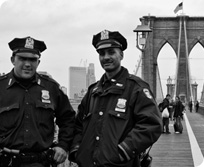City Youth and the NYPD
Amid the flood of analysis that followed the NYPD's release of data on its use of "stop, question and frisk" policing tactics, researchers recently released a survey showing widespread mistrust of police among 1,100 New Yorkers between the ages of 14 and 21.
 The survey was conducted by the Polling for Justice project at the City University of New York, a collective of youth and adult researchers who developed the questions and distributed them through their own networks and those of community organizations. The participants were not as demographically representative of the city as a random sample would have been, nearly two-thirds of respondents were female and just 9 percent were white (whites accounted for 22 percent of the city's young people in the 2010 census).
The survey was conducted by the Polling for Justice project at the City University of New York, a collective of youth and adult researchers who developed the questions and distributed them through their own networks and those of community organizations. The participants were not as demographically representative of the city as a random sample would have been, nearly two-thirds of respondents were female and just 9 percent were white (whites accounted for 22 percent of the city's young people in the 2010 census).
Nevertheless, researchers set out to have a pool that reflected the racial, ethnic and socioeconomic differences among city public high school students and for the most part they did. Survey participants were geographically dispersed across all of the city's boroughs except for Staten Island.
Nearly half of the young people reported having negative interactions with police in the previous six months. Just 20 percent said they would feel comfortable going to the police if they needed help.
The survey data were collected in 2008 and 2009, when the NYPD used stop and frisk tactics on young people aged 14-21 more than 416,000 times, according to the CUNY researchers' analysis of NYPD data. This amounts to nearly 40 percent of all such stops.
The NYPD data show that young people were frisked in the majority (61 percent) of the stops and 1 percent of stops resulted in the discovery of a weapon. They also show that young people were stopped at an average of once every 90 minutes in high-poverty, majority black and Latino neighborhoods like East New York and Brownsville, Brooklyn, while whiter, wealthier areas averaged one stop every 18 hours.
By pairing the NYPD data with young people's accounts of their experiences, the researchers sought to document details and nuances that don't show up in the official numbers. "Young people are particularly vulnerable to the ebbs and flows of public institutions and local environments, yet they are seldom included in the discussion on what their experiences have been, what needs to change, and in what ways those changes should happen," says Brett Stoudt, a professor at CUNY's John Jay College of Criminal Justice and one of the lead researchers on the survey.
Young people who reported negative incidents with police were likely to have experienced them multiple times over the previous six months, with more than 40 percent reporting three or more stops. Twelve percent of the survey participants reported unwanted sexual attention from the police, or that they were touched inappropriately during a search.
Lesbian, gay, bisexual and questioning youth were significantly more likely to have experienced negative interactions with police (61 percent) than young people who identified as straight (47 percent.)
Unsurprisingly, young people's perceptions of their own interactions with police corresponded with their general feelings about the NYPD. Among the survey participants who reported having only positive interactions with police, nearly 70 percent agreed with the statement that "in general, the police in NYC protect young people like me," though even that category of young people were unlikely (28 percent) to say they'd feel comfortable turning to police for help.
Among respondents who reported negative contacts with police, just 31 percent said they felt protected by police, and only 16 percent said they'd turn to police if they were in trouble.
That lack of trust may actually facilitate crime, says Stoudt, since it can limit police officers' ability to partner with community members. "We need to start considering what it means for the youth in NYC to grow up policed; to grow up as perpetual suspects because of how they look or where they live," he says.
The cycle of mistrust won't be broken until police are trained to look for individual behaviors that indicate possible criminal activities, rather than relying on contextual indicators like neighborhood or style of dress, says Delores Jones Brown, who directs the Center on Race, Crime and Justice at John Jay College. "A very small minority of young people, even in areas of high crime, are involved in serious criminal activities," she says. "Police need to learn to distinguish between those kids, in the same way as they do in white communities."
The NYPD press office did not respond to a request for comment. The Department of Probation's press office offered the following statement about the city's law enforcement strategies: "Since the early 1990s, there has been a 56 percent reduction in the number of New York City residents sent to state prison, thanks in large part to the NYPD's success in driving down murder and other serious crime. The city has also successfully reduced the number of youth who are detained in New York City or placed in upstate facilities. Both of these reductions speak to our ability to protect public safety while ensuring that all youth, including those who are most at-risk-have the opportunity to become successful members of their communities."
Photo: Stephane Bazart photography/flickrCC
